Market Overview
The global smart electronics market is projected to reach USD 1,299.8 billion in 2025 and is expected to grow to USD 2,360.7 billion by 2034, expanding at a CAGR of 6.9%. The market growth is driven by growing adoption of connected devices, Internet of Things integration, AI-enabled electronics, and rising demand for automation across consumer, automotive, healthcare, and industrial applications.
Smart electronics refer to electronic devices and systems that integrate advanced technologies such as sensors, artificial intelligence, connectivity modules, and data processing capabilities to perform intelligent functions beyond traditional electronic components. These devices are designed to interact seamlessly with users and other systems, enabling automation, remote control, real-time monitoring, and predictive analysis.
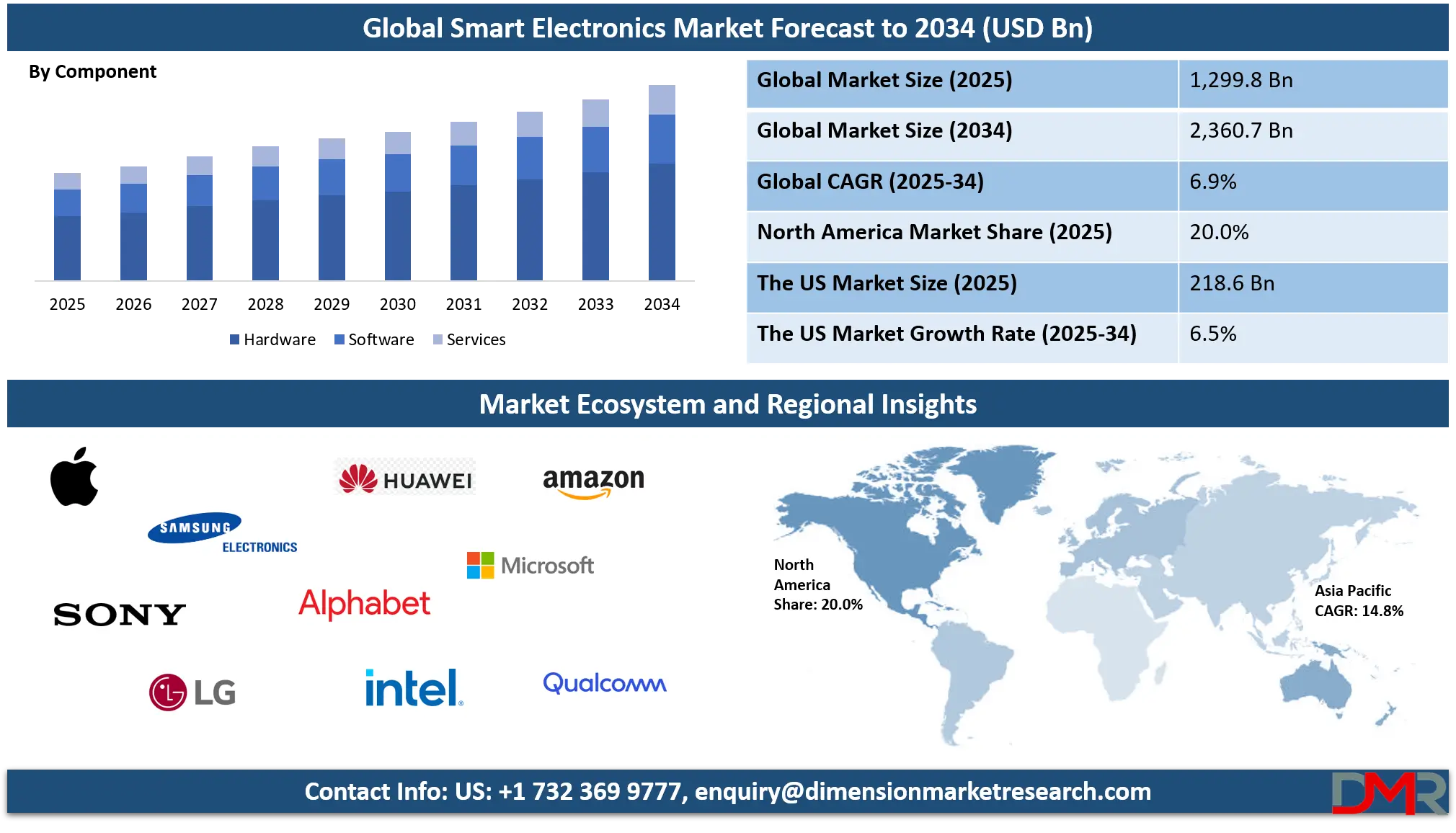
They encompass a wide range of applications including consumer gadgets, home automation systems, healthcare monitoring devices, automotive electronics, and industrial equipment. By combining hardware, software, and communication protocols, smart electronics enhance efficiency, convenience, and user experience while enabling the collection and analysis of valuable data to support informed decision-making.
The global smart electronics market encompasses the entire ecosystem of intelligent devices, components, platforms, and services that drive modern connected technologies. It includes consumer electronics such as smartphones, wearables, and smart televisions, home automation solutions like connected appliances and security systems, healthcare devices that monitor physiological parameters, automotive electronics for advanced driver assistance, and industrial applications involving industrial internet of things and enterprise wearables.
Market growth is fueled by growing demand for automation, rising adoption of internet of things technologies, integration of artificial intelligence, and the proliferation of connected devices in both personal and professional settings.
This market is also characterized by continuous technological innovation, evolving consumer preferences, and the expansion of smart infrastructure in emerging economies. Key factors influencing the market include advancements in semiconductor technologies, widespread adoption of 5G and wireless connectivity, energy efficiency trends, and a growing focus on health monitoring and sustainable devices. The competitive landscape is marked by major multinational corporations and innovative startups investing in research and development to introduce new products and solutions that enhance functionality, user experience, and interoperability across ecosystems.
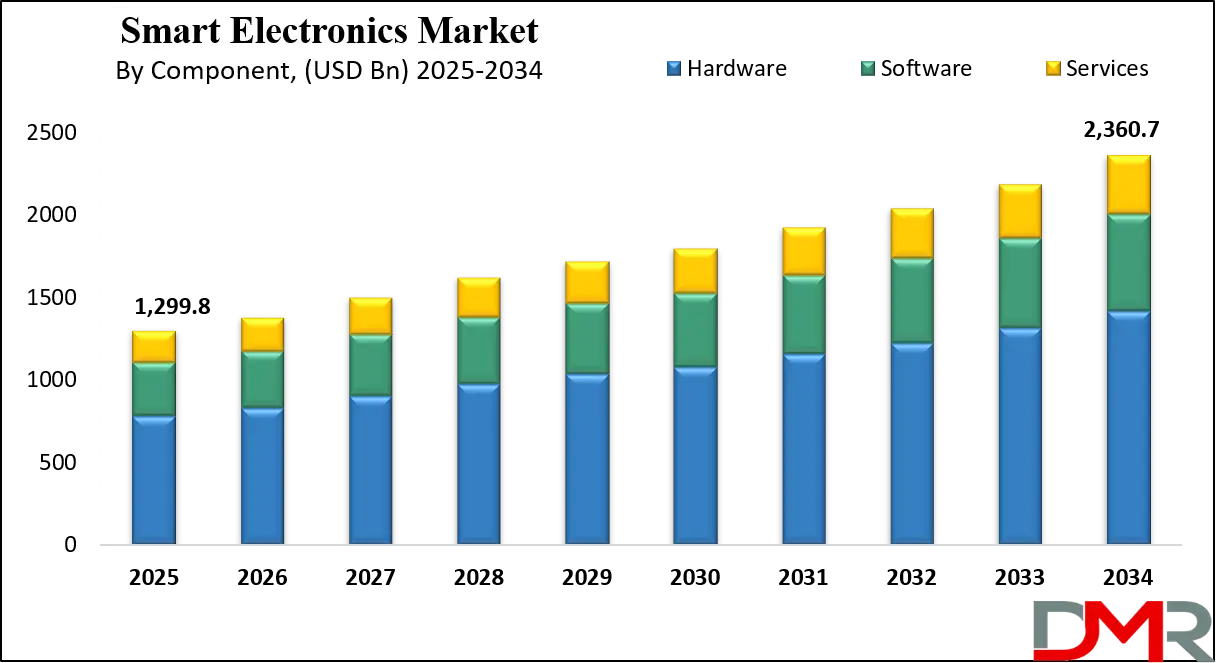
The US Smart Electronics Market
The US Smart Electronics Market is projected to be valued at USD 218.6 billion in 2025. It is expected to witness subsequent growth in the upcoming period as it holds USD 384.8 billion in 2034 at a CAGR of 6.5%.
The US smart electronics market represents one of the most advanced and dynamic segments of the global connected technology ecosystem, driven by rapid adoption of Internet of Things devices, artificial intelligence integration, and next-generation connectivity solutions. Consumer electronics, including smartphones, smartwatches, and home entertainment systems, dominate the landscape, while smart home automation solutions such as connected appliances, security systems, and voice-enabled assistants are witnessing robust growth.
High disposable income, tech-savvy consumers, and the presence of leading technology innovators fuel demand, while enterprise adoption of industrial IoT devices and AI-powered analytics further strengthens the market. Continuous innovation in semiconductor technologies, edge computing, and sensor integration is also enabling smarter, more efficient devices, enhancing interoperability and real-time data processing across multiple sectors.
In addition, the US smart electronics market is being shaped by regulatory support for energy-efficient devices, increased investment in smart infrastructure, and the expansion of 5G networks, which together facilitate faster connectivity and seamless integration of intelligent systems. Healthcare electronics, including wearable health monitors, remote patient monitoring devices, and smart diagnostic tools, are gaining traction amid rising focus on preventive care and chronic disease management.
Automotive electronics, particularly advanced driver-assistance systems and in-car infotainment solutions, continue to expand as vehicle electrification and autonomous technologies advance. Overall, the market demonstrates a strong convergence of consumer demand, industrial application, and technological innovation, positioning the US as a key hub for smart electronics development and deployment globally.
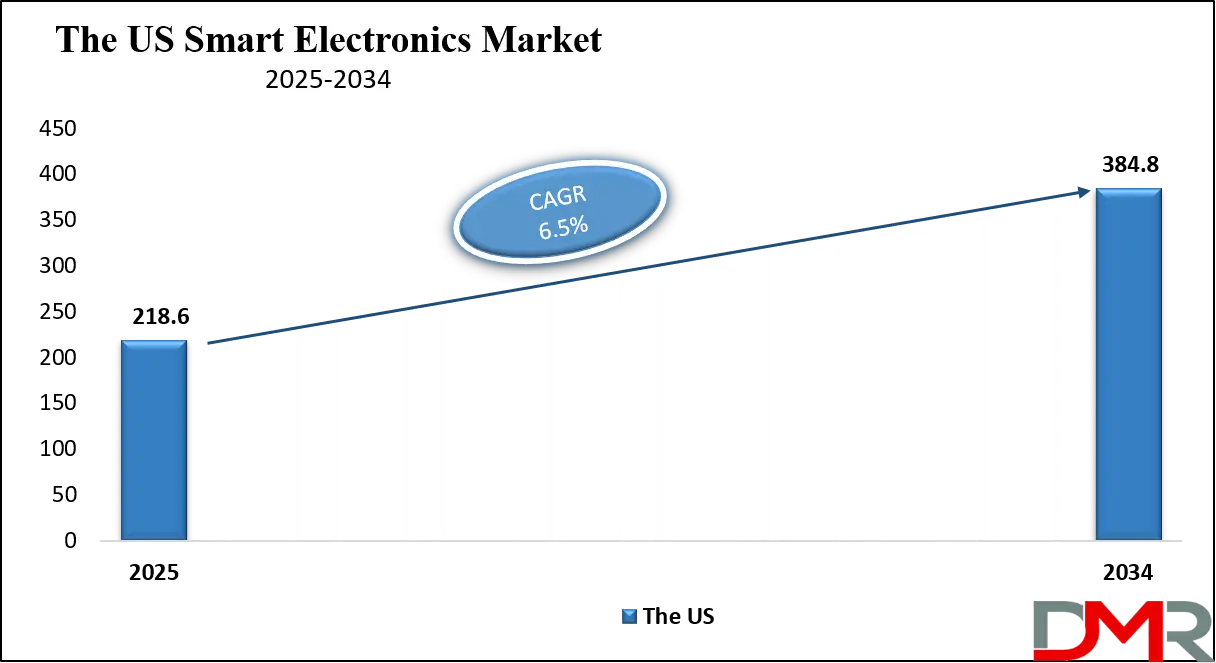
Europe Smart Electronics Market
The Europe smart electronics market is projected to reach a value of USD 178.0 billion in 2025, reflecting strong demand across both consumer and industrial segments. The market growth is primarily driven by growing adoption of connected devices, including smartphones, wearable technology, and smart home appliances. Rising consumer awareness about energy-efficient and AI-enabled devices, integrated with high disposable incomes in Western European countries, supports the expansion of this market. Technological advancements in sensors, wireless communication, and IoT platforms are further enhancing the functionality and interoperability of smart electronic devices, making them more appealing to European consumers.
Industrial and enterprise applications are also contributing significantly to market growth in Europe. Adoption of industrial IoT solutions, connected manufacturing equipment, and AI-powered analytics is transforming operations across automotive, healthcare, and manufacturing sectors. Smart energy management systems and automation technologies are increasingly implemented to optimize resource utilization, reduce operational costs, and improve efficiency.
Supportive government initiatives promoting digital infrastructure, smart city projects, and energy-efficient technologies are further driving adoption. Overall, these factors position Europe as a key regional market in the global smart electronics landscape, with a steady CAGR of 6.3% projected through the coming years.
Japan Smart Electronics Market
The Japan smart electronics market is projected to reach USD 68.7 billion in 2025, driven by high consumer adoption of advanced technologies and a strong focus on innovation in connected devices. Consumer electronics such as smartphones, smartwatches, smart TVs, and wearable health devices are widely popular, supported by tech-savvy populations and a culture that embraces new technology. Integration of artificial intelligence, Internet of Things platforms, and high-speed connectivity in these devices enhances user convenience, personalization, and efficiency, making smart electronics increasingly indispensable in daily life.
In addition to consumer applications, industrial and enterprise sectors are key contributors to market growth in Japan. Advanced manufacturing technologies, industrial IoT solutions, robotics, and AI-powered automation are widely adopted to improve productivity, reduce downtime, and optimize resource utilization. The government’s initiatives supporting smart factories, energy-efficient solutions, and digital infrastructure further accelerate market expansion. With continuous innovation in hardware, software, and connectivity, Japan is positioned as a critical regional hub in the global smart electronics market, achieving a projected CAGR of 7.6% through the coming years.
Global Smart Electronics Market: Key Takeaways
- Market Value: The global Smart Electronics market size is expected to reach a value of USD 2,360.7 billion by 2034 from a base value of USD 1,299.8 billion in 2025 at a CAGR of 6.9%.
- By Product Type Segment Analysis: Consumer Electronics are anticipated to dominate the product type segment, capturing 50.0% of the total market share in 2025.
- By Component Segment Analysis: Hardware is expected to maintain its dominance in the component segment, capturing 60.0% of the total market share in 2025.
- By Application Segment Analysis: Personal & Consumer will dominate the application segment, capturing 55.0% of the market share in 2025.
- Regional Analysis: Asia Pacific is anticipated to lead the global Smart Electronics market landscape with 35.0% of total global market revenue in 2025.
- Key Players: Some key players in the global Smart Electronics market include Apple Inc., Samsung Electronics, Sony Group Corporation, LG Electronics, Huawei Technologies, Google (Alphabet Inc.), Amazon.com, Inc., Microsoft Corporation, Intel Corporation, Qualcomm Incorporated, NVIDIA Corporation, Xiaomi Corporation, Panasonic Corporation, Bosch Group, Siemens AG, Honeywell International Inc., Schneider Electric, and Others.
Global Smart Electronics Market: Use Cases
- Smart Home Automation: Smart home automation is one of the most prominent applications in the global smart electronics market. Connected devices such as smart lighting systems, thermostats, security cameras, smart locks, and voice-enabled assistants allow homeowners to control and monitor their environment remotely. Integration with Internet of Things platforms and AI-enabled devices enables energy optimization, predictive maintenance, and enhanced security. The growing adoption of home IoT ecosystems and demand for convenience-driven lifestyles are driving growth in this segment.
- Wearable Health and Fitness Devices: Wearable health and fitness electronics are revolutionizing personal healthcare by providing continuous monitoring of vital signs, activity levels, and sleep patterns. Devices such as smartwatches, ECG monitors, glucose trackers, and fitness bands utilize sensors and AI-powered analytics to deliver actionable insights. These products support preventive care, chronic disease management, and real-time health monitoring. Rising consumer awareness, demand for remote healthcare solutions, and integration with mobile apps and cloud platforms are fueling this use case.
- Automotive Electronics and Connected Vehicles: The automotive sector leverages smart electronics for advanced driver-assistance systems, in-car infotainment, navigation, and electric vehicle management. Sensors, embedded systems, and AI algorithms improve safety, performance, and driver convenience. Smart connectivity features such as vehicle-to-everything communication, predictive maintenance, and autonomous driving support the transformation toward connected and self-driving vehicles. Increasing EV adoption and regulatory focus on road safety contribute to market expansion in this segment.
- Industrial IoT and Smart Manufacturing: Industrial applications of smart electronics include connected sensors, automated machinery, and enterprise wearables that enhance productivity, efficiency, and operational safety. Industrial IoT platforms collect real-time data from equipment, enabling predictive maintenance, energy management, and process optimization. The integration of AI, robotics, and cloud computing allows manufacturers to implement smart factories with minimal downtime and improved quality control. Growth is driven by Industry 4.0 initiatives, automation trends, and demand for data-driven industrial operations.
Impact of Artificial Intelligence on the global Smart Electronics market
The impact of artificial intelligence on the global smart electronics market is transformative, reshaping device functionality, user experience, and operational efficiency across multiple sectors. AI integration enables smart devices to process large volumes of data, recognize patterns, and make predictive decisions, which enhances automation and personalization in both consumer and industrial applications. In consumer electronics, AI powers intelligent voice assistants, recommendation engines in smart TVs, adaptive learning in wearable devices, and predictive maintenance in connected home appliances.
In industrial and enterprise applications, AI-driven analytics optimize production lines, improve equipment reliability, and enhance energy efficiency through predictive monitoring and real-time decision-making. Automotive electronics also benefit from AI through autonomous driving systems, advanced driver-assistance features, and smart traffic management.
Furthermore, AI facilitates innovation in healthcare electronics by enabling remote patient monitoring, early disease detection, and personalized health insights. Overall, AI acts as a key growth driver for the global smart electronics market, fostering smarter, more efficient, and interconnected devices across all segments.
Global Smart Electronics Market: Stats & Facts
India Ministry of Electronics and Information Technology (MeitY)
- India’s electronics manufacturing sector more than doubled, reaching USD 115 billion in 2024.
- The government plans to offer USD 4–5 billion in incentives to local electronics firms to reduce import dependency.
- India aims to expand its electronics manufacturing to USD 500 billion by 2030.
- The government is establishing Electronics System Design and Manufacturing (ESDM) Parks in Uttar Pradesh to enhance growth in electronics and semiconductor sectors.
China Ministry of Industry and Information Technology (MIIT)
- China is projected to invest USD 38 billion in chipmaking equipment in 2025, leading global investments.
- The country aims to reduce dependency on imported chips and counter U.S. restrictions through this investment.
U.S. Department of Commerce
- The department announced negotiations to invest up to USD 300 million in advanced packaging research projects in Georgia, California, and Arizona.
- These investments aim to accelerate the development of cutting-edge technologies essential to the semiconductor industry.
European Commission
- The European Union is investing in digital infrastructure and smart city projects to enhance the adoption of smart electronics.
- The EU's Digital Compass plan aims to achieve 100% 5G coverage across urban areas by 2030.
Global Smart Electronics Market: Market Dynamics
Global Smart Electronics Market: Driving Factors
Rapid Adoption of Internet of Things and Connected Devices
The proliferation of IoT-enabled devices is accelerating the growth of the smart electronics market. Consumers and enterprises increasingly rely on connected electronics for automation, remote monitoring, and data-driven decision-making. Integration of sensors, wireless connectivity, and cloud platforms enables seamless interoperability among devices, improving efficiency and user experience. This trend is particularly strong in smart homes, industrial automation, and wearable technology, driving demand for intelligent and connected solutions globally.
Advancements in Artificial Intelligence and Machine Learning
AI and machine learning technologies are enhancing the intelligence and functionality of smart electronics. From predictive analytics in industrial equipment to adaptive algorithms in consumer wearables, AI enables devices to learn from user behavior, optimize performance, and provide personalized experiences. Integration of AI into home automation systems, smart healthcare devices, and automotive electronics significantly increases market attractiveness by delivering smarter, more efficient, and proactive solutions.
Global Smart Electronics Market: Restraints
High Cost of Advanced Smart Electronics
The upfront cost of AI-enabled devices, industrial IoT systems, and high-performance consumer electronics can be a barrier to adoption. Premium pricing for sophisticated smart devices, including wearable health monitors, smart appliances, and connected vehicles, limits penetration in price-sensitive markets and emerging economies. Cost concerns can slow adoption among consumers and small-to-medium enterprises, restraining overall market growth.
Data Privacy and Security Concerns
Smart electronics rely heavily on data collection, cloud storage, and connectivity, which exposes users and enterprises to potential cybersecurity threats. Concerns regarding unauthorized access, data breaches, and misuse of personal information can affect consumer confidence and hinder market expansion. Stringent regulations and the need for robust encryption and privacy measures add complexity to product development and deployment.
Global Smart Electronics Market: Opportunities
Expansion of Smart Healthcare and Wearable Devices
There is significant potential in developing advanced wearable health monitors, remote patient monitoring systems, and AI-driven diagnostic devices. Rising demand for preventive healthcare, chronic disease management, and telemedicine creates opportunities for innovative smart electronics solutions. Integration of IoT platforms and mobile apps enhances data collection, analytics, and patient engagement, creating new avenues for growth in healthcare electronics.
Growth in Industrial IoT and Smart Manufacturing
Industry 4.0 initiatives and automation trends are driving the adoption of industrial IoT devices, connected sensors, and smart factory equipment. These solutions enable predictive maintenance, real-time monitoring, and optimized production processes. Integration of AI, cloud computing, and robotics enhances operational efficiency and reduces downtime, presenting significant opportunities for enterprises to implement data-driven and intelligent manufacturing systems.
Global Smart Electronics Market: Trends
Integration of 5G and High-Speed Connectivity
The rollout of 5G networks is enabling faster communication between smart devices, reducing latency, and improving real-time data exchange. High-speed connectivity supports IoT ecosystems, autonomous vehicles, remote healthcare monitoring, and smart city infrastructure, enhancing device interoperability and responsiveness.
Focus on Energy Efficiency and Sustainable Electronics
Sustainability is becoming a key trend in the smart electronics market, with increased demand for energy-efficient appliances, low-power wearables, and eco-friendly devices. Manufacturers are adopting green technologies, recyclable materials, and energy management solutions to reduce environmental impact while meeting regulatory requirements and consumer expectations.
Global Smart Electronics Market: Research Scope and Analysis
By Product Type Analysis
In the global smart electronics market, the consumer electronics segment is anticipated to dominate the product type category, capturing 50.0% of the total market share in 2025. This leadership is driven by the widespread adoption of smartphones, wearables such as smartwatches and fitness trackers, smart televisions, and connected audio systems. Consumers increasingly demand devices that provide enhanced functionality, connectivity, and convenience, allowing seamless integration into daily life.
Continuous technological advancements in AI, sensors, and wireless communication enable smarter, more intuitive, and interactive devices. High disposable income, tech-savvy populations, and rapid innovation in consumer gadgets further reinforce the dominance of this segment in the overall market.
The home automation and IoT devices segment is also witnessing robust growth within the smart electronics market. This segment includes smart home appliances, security systems, and voice-enabled assistants that enable automation, remote monitoring, and energy management in residential settings. Integration with Internet of Things platforms allows devices to communicate with each other and with users, providing convenience, improved efficiency, and enhanced security.
Increasing urbanization, rising consumer awareness of smart home benefits, and the growing popularity of connected ecosystems are driving the adoption of home automation solutions. Innovations in AI-enabled control systems, cloud connectivity, and predictive maintenance features are further enhancing the efficiency and usability of these smart home devices.
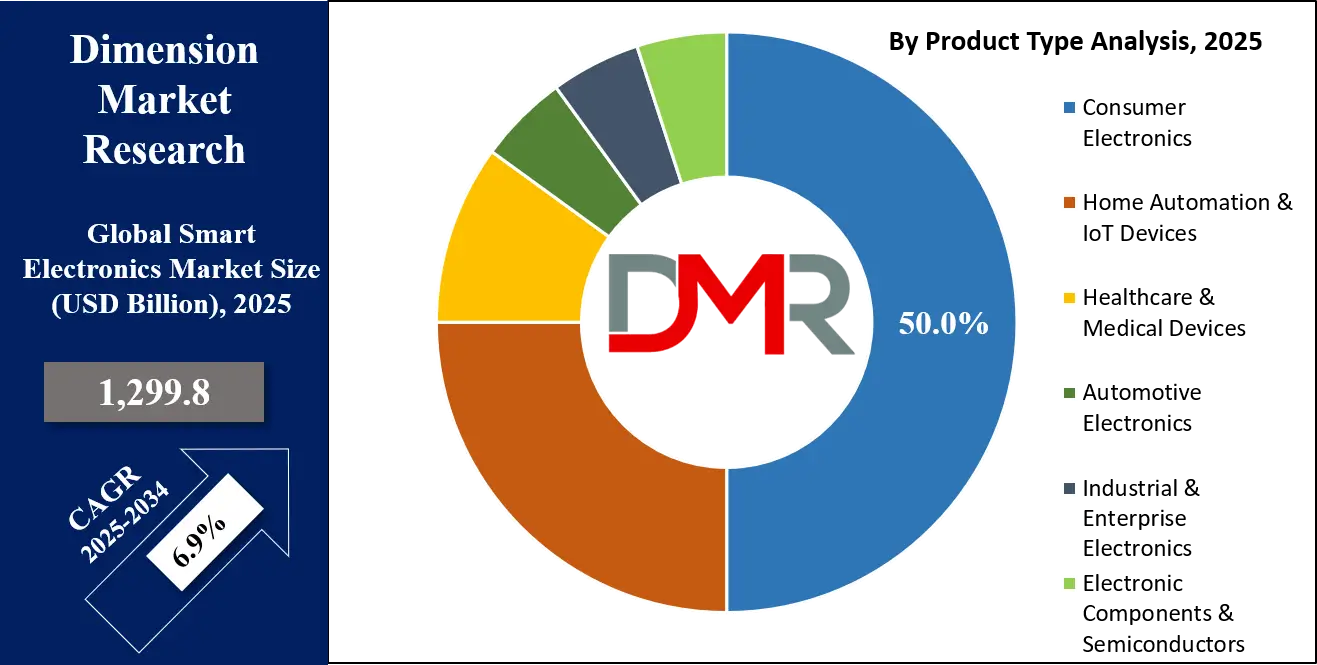
By Component Analysis
In the global smart electronics market, the hardware component segment is expected to maintain its dominance, capturing 60.0% of the total market share in 2025. This segment includes critical elements such as processors, memory chips, sensors, actuators, and connectivity modules, which form the backbone of all smart electronic devices. The demand for high-performance, reliable, and energy-efficient hardware is driving growth, as consumers and enterprises seek devices that offer faster processing, improved functionality, and seamless connectivity.
Continuous innovations in semiconductor technologies, miniaturization of components, and integration of advanced sensors are further strengthening the hardware segment's position as a core driver of the smart electronics ecosystem.
The software segment of the smart electronics market is also experiencing significant growth, fueled by the need for intelligent device management, IoT platform integration, and AI-driven analytics. Software solutions enable devices to communicate, process data, and deliver personalized user experiences, enhancing the overall value of smart electronics.
Applications include device operating systems, cloud-based IoT platforms, analytics software, and AI algorithms that optimize performance, predictive maintenance, and remote monitoring. As smart electronics become increasingly interconnected, the demand for scalable, secure, and user-friendly software solutions continues to expand, supporting the efficient operation and interoperability of hardware components across consumer, industrial, and enterprise applications.
By Application Analysis
In the global smart electronics market, the personal and consumer application segment is expected to dominate, capturing 55.0% of the market share in 2025. This segment includes devices and solutions designed to enhance daily life, such as smartphones, smartwatches, wearable fitness trackers, smart televisions, and connected audio systems.
The strong growth of this segment is driven by growing consumer demand for convenience, connectivity, and personalization in their devices. Integration of artificial intelligence, advanced sensors, and Internet of Things platforms allows these products to deliver smarter and more interactive experiences. Rising disposable income, urbanization, and tech-savvy populations further reinforce the prominence of the personal and consumer segment in the overall smart electronics market.
The automotive and transportation application segment is also growing rapidly within the smart electronics market. This includes advanced driver-assistance systems, in-car infotainment, navigation solutions, and electric vehicle management systems. Smart sensors, embedded systems, and AI algorithms enhance vehicle safety, performance, and user convenience, while connected technologies such as vehicle-to-everything communication and predictive maintenance improve operational efficiency. The growing adoption of electric vehicles, autonomous driving technologies, and regulatory emphasis on road safety are driving demand for smart electronics in the automotive sector, making it a significant growth area within the overall market.
The Smart Electronics Market Report is segmented on the basis of the following:
By Product Type
- Consumer Electronics
- Smartphones
- Wearables
- Smart TVs & Audio Systems
- Home Automation & IoT Devices
- Smart Home Appliances
- Security Systems
- Voice Assistants
- Healthcare & Medical Devices
- Automotive Electronics
- Advanced Driver-Assistance Systems (ADAS)
- In-car Infotainment Systems
- Industrial & Enterprise Electronics
- Industrial IoT Devices
- Enterprise Wearables
- Electronic Components & Semiconductors
- ICs
- Sensors
- Optoelectronics
By Component
- Hardware
- Software
- Services
By Application
- Personal & Consumer
- Automotive & Transportation
- Industrial & Enterprise
- Healthcare
- Others
Global Smart Electronics Market: Regional Analysis
Region with the Largest Revenue Share
Asia Pacific is anticipated to lead the global smart electronics market landscape, capturing 35.0% of the total market revenue in 2025. The region's dominance is driven by strong manufacturing capabilities, high consumer adoption of connected devices, and rapid urbanization. Countries such as China, Japan, South Korea, and India are major contributors, supported by the presence of leading technology companies and robust investment in research and development.
The widespread adoption of smartphones, wearable devices, smart home appliances, and industrial IoT solutions, along with government initiatives promoting digital infrastructure and smart city projects, further strengthen the region’s leadership in the global smart electronics market.
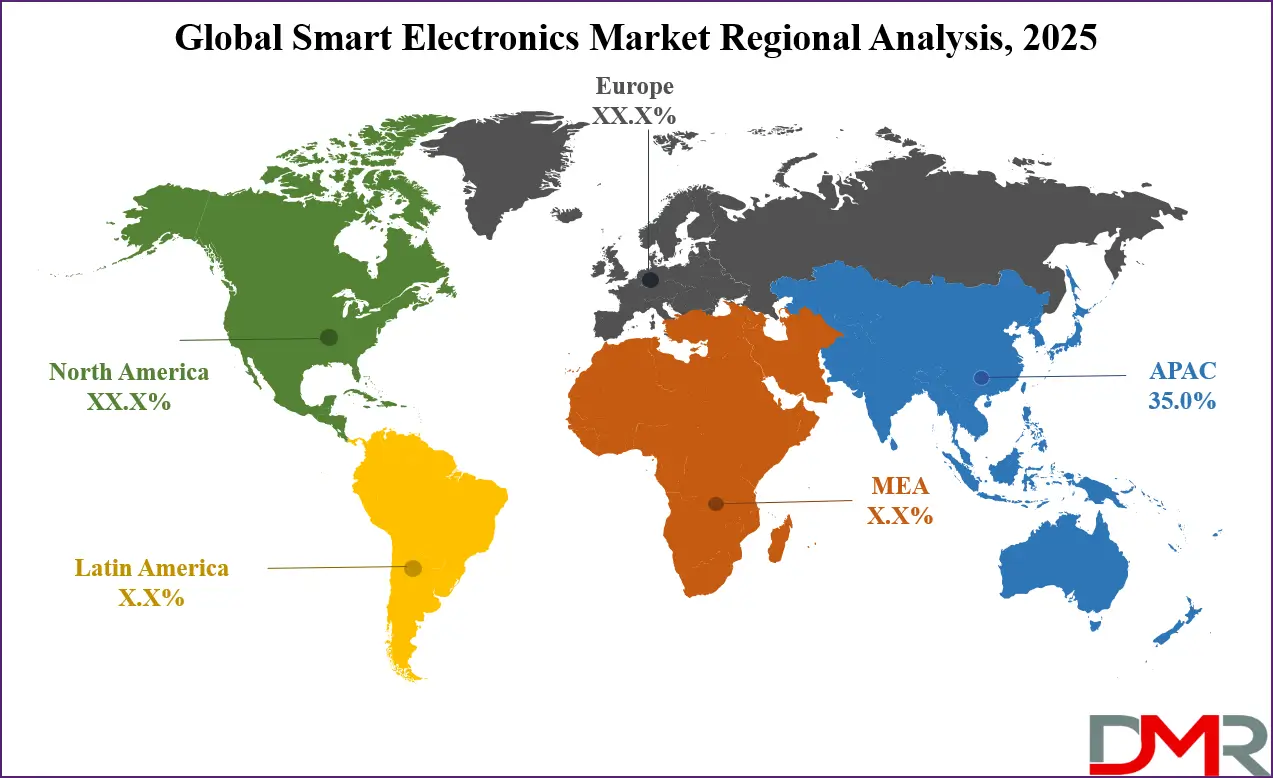
Region with significant growth
The Middle East and Africa region is witnessing significant growth in the global smart electronics market, driven by growing adoption of smart home devices, connected consumer electronics, and industrial IoT solutions. Rising urbanization, growing internet penetration, and expanding digital infrastructure are fueling demand for connected and automated technologies.
Governments in key countries are investing in smart city initiatives and energy-efficient solutions, creating opportunities for both established and emerging players. Additionally, growing awareness of healthcare monitoring devices and wearable technology is contributing to the accelerated adoption of smart electronics across residential, commercial, and industrial applications in the region.
By Region
North America
Europe
- Germany
- The U.K.
- France
- Italy
- Russia
- Spain
- Benelux
- Nordic
- Rest of Europe
Asia-Pacific
- China
- Japan
- South Korea
- India
- ANZ
- ASEAN
- Rest of Asia-Pacific
Latin America
- Brazil
- Mexico
- Argentina
- Colombia
- Rest of Latin America
Middle East & Africa
- Saudi Arabia
- UAE
- South Africa
- Israel
- Egypt
- Rest of MEA
Global Smart Electronics Market: Competitive Landscape
The global smart electronics market features a highly competitive landscape, dominated by leading multinational corporations and innovative technology companies. Key players such as Apple, Samsung, Sony, LG, Huawei, Google, Amazon, Microsoft, Intel, and Qualcomm focus on continuous research and development to introduce advanced consumer electronics, home automation systems, wearable devices, and automotive solutions.
Companies are leveraging strategic partnerships, mergers, and acquisitions to expand their product portfolios and strengthen their market presence. Competition is driven by technological innovation, product differentiation, brand recognition, and the ability to offer integrated hardware, software, and connectivity solutions that meet evolving consumer and enterprise demands.
Some of the prominent players in the global Smart Electronics market are:
- Apple Inc.
- Samsung Electronics
- Sony Group Corporation
- LG Electronics
- Huawei Technologies
- Google (Alphabet Inc.)
- Amazon.com, Inc.
- Microsoft Corporation
- Intel Corporation
- Qualcomm Incorporated
- NVIDIA Corporation
- Xiaomi Corporation
- Panasonic Corporation
- Bosch Group
- Siemens AG
- Honeywell International Inc.
- Schneider Electric
- Johnson Controls International
- Haier Group Corporation
- Foxconn Technology Group
- Other Key Players
Global Smart Electronics Market: Recent Developments
- September 2025: Meta introduced the Oakley Meta Vanguard smart glasses, priced at USD 499. Designed for athletes, these glasses feature a centered action camera, improved speakers, and enhanced water resistance. They integrate with Meta’s AI app and fitness platforms like Garmin and Strava, offering real-time training stats and post-workout summaries.
- September 2025: Meta unveiled its first consumer-ready smart glasses with a built-in augmented reality (AR) display, the Meta Ray-Ban Display. Priced at USD 799, these glasses feature an in-lens display, camera, speakers, and microphone. They support tasks like video calls, messaging, translating, and navigation, and include AI voice control and a water-resistant Neural Band bracelet for gesture-based interaction. Sales begin in the U.S. on September 30, with international availability expected in 2026.
- May 2025: Samsung Electronics announced the acquisition of FläktGroup, a European market leader in energy-efficient ventilation and precision-cooling solutions, for €1.5 billion. This move aims to expand Samsung's presence in the smart home and energy-efficient solutions sector.
Report Details
| Report Characteristics |
| Market Size (2025) |
USD 1,299.8 Bn |
| Forecast Value (2034) |
USD 2,360.7 Bn |
| CAGR (2025–2034) |
6.9% |
| The US Market Size (2025) |
USD 218.6 Bn |
| Historical Data |
2019 – 2024 |
| Forecast Data |
2026 – 2034 |
| Base Year |
2024 |
| Estimate Year |
2025 |
| Report Coverage |
Market Revenue Estimation, Market Dynamics, Competitive Landscape, Growth Factors, etc. |
| Segments Covered |
By Product Type (Consumer Electronics, Home Automation & IoT Devices, Healthcare & Medical Devices, Automotive Electronics, Industrial & Enterprise Electronics, Electronic Components & Semiconductors), By Component (Hardware, Software, Services), and By Application (Personal & Consumer, Automotive & Transportation, Industrial & Enterprise, Healthcare, Others) |
| Regional Coverage |
North America – US, Canada; Europe – Germany, UK, France, Russia, Spain, Italy, Benelux, Nordic, Rest of Europe; Asia-Pacific – China, Japan, South Korea, India, ANZ, ASEAN, Rest of APAC; Latin America – Brazil, Mexico, Argentina, Colombia, Rest of Latin America; Middle East & Africa – Saudi Arabia, UAE, South Africa, Turkey, Egypt, Israel, Rest of MEA |
| Prominent Players |
Apple Inc., Samsung Electronics, Sony Group Corporation, LG Electronics, Huawei Technologies, Google (Alphabet Inc.), Amazon.com, Inc., Microsoft Corporation, Intel Corporation, Qualcomm Incorporated, NVIDIA Corporation, Xiaomi Corporation, Panasonic Corporation, Bosch Group, Siemens AG, Honeywell International Inc., Schneider Electric, and Others |
| Purchase Options |
We have three licenses to opt for: Single User License (Limited to 1 user), Multi-User License (Up to 5 Users), and Corporate Use License (Unlimited User) along with free report customization equivalent to 0 analyst working days, 3 analysts working days, and 5 analysts working days respectively. |
Frequently Asked Questions
The global Smart Electronics market size is estimated to have a value of USD 1,299.8 billion in 2025 and is expected to reach USD 2,360.7 billion by the end of 2034.
The US Smart Electronics market is projected to be valued at USD 218.6 billion in 2025. It is expected to witness subsequent growth in the upcoming period as it holds USD 384.8 billion in 2034 at a CAGR of 6.5%.
Asia Pacific is expected to have the largest market share in the global Smart Electronics market, with a share of about 35.0% in 2025.
Some of the major key players in the global Smart Electronics market are Apple Inc., Samsung Electronics, Sony Group Corporation, LG Electronics, Huawei Technologies, Google (Alphabet Inc.), Amazon.com, Inc., Microsoft Corporation, Intel Corporation, Qualcomm Incorporated, NVIDIA Corporation, Xiaomi Corporation, Panasonic Corporation, Bosch Group, Siemens AG, Honeywell International Inc., Schneider Electric, and Others.
The market is growing at a CAGR of 6.9 percent over the forecasted period.